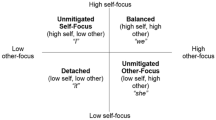Abstract
The present study examined effects of temporarily salient and chronic self-construal on decoding accuracy for positive and negative facial expressions of emotion. We primed independent and interdependent self-construal in a sample of participants who then rated the emotion expressions of a central character (target) in a cartoon showing a happy, sad, angry, or neutral facial expression in a group setting. Primed interdependence was associated with lower recognition accuracy for negative emotion expressions. Primed and chronic self-construal interacted such that for interdependence primed participants, higher chronic interdependence was associated with lower decoding accuracy for negative emotion expressions. Chronic independent self-construal was associated with higher decoding accuracy for negative emotion. These findings add to an increasing literature that highlights the significance of perceivers’ socio-cultural factors, self-construal in particular, for emotion perception.


Similar content being viewed by others
References
Aiken, L. S., & West, S. G. (1991). Multiple regression: Testing and interpreting interactions. Newbury Park, CA: Sage Publications.
Barrett, L. F., & Kensinger, E. A. (2010). Context is routinely encoded during emotion perception. Psychological Science, 21, 595–599.
Beaupré, M. G., & Hess, U. (2005). Cross-cultural emotion recognition among Canadian ethnic groups. Journal of Cross-Cultural Psychology, 36, 355–370.
Biehl, M., Matsumoto, D., Ekman, P., Hearn, V., Heider, K., Kudoh, T., et al. (1997). Matsumoto and Ekman’s Japanese and Caucasian facial expressions of emotion (JACFEE): Reliability data and cross-national differences. Journal of Nonverbal Behavior, 21(1), 3–21.
Cross, S. E., Hardin, E. E., & Gercek-Swing, B. (2011). The what, how, why, and where of self-construal. Personality and Social Psychology Review, 15, 142–179.
Dion, K. L. (1996). Ethnolinguistic correlates of alexithymia: Toward a cultural perspective. Journal of Psychosomatic Research, 41, 531–539.
Ekman, P., & Friesen, W. V. (1971). Constants across cultures in the face and emotion. Journal of Personality and Social Psychology, 17, 124–129.
Elfenbein, H. A., Beaupré, M. G., Levesque, M., & Hess, U. (2007). Toward a dialect theory: Cultural differences in the expression and recognition of posed facial expressions. Emotion, 7, 131–146.
Hall, J. A., Andrzejewski, S. A., & Yopchick, J. E. (2009). Psychosocial correlates of interpersonal sensitivity: A meta-analysis. Journal of Nonverbal Behavior, 33, 149–180.
Hareli, S., & Hess, U. (2010). What emotional reactions can tell us about the nature of others: An appraisal perspective on person perception. Cognition and Emotion, 24, 128–140.
Hess, U., Adams, R. B, Jr, & Kleck, R. E. (2007). Looking at you or looking elsewhere: The influence of head orientation on the signal value of emotional facial expressions. Motivation and Emotion, 31, 137–144.
Hess, U., Adams, R. B., Simard, A., Stevenson, M. T., & Kleck, R. E. (2012). Smiling and sad wrinkles: Age-related changes in the face and the perception of emotions and intentions. Journal of Experimental Social Psychology, 48, 1377–1380.
Hess, U. & Kafetsios, K. (2013). Accuracy and bias in emotion perception: From labs to life. (Manuscript under review).
Hess, U., & Thibault, P. (2009). Darwin and emotion expression. American Psychologist, 64, 120–128.
Johnson, K. J., Waugh, C. E., & Fredrickson, B. L. (2010). Smile to see the forest: Facially expressed positive emotions broaden cognition. Cognition and Emotion, 24, 299–321.
Kafetsios, K., & Hess, U. (2013). Are you looking at me? The influence of facial orientation and self-construal activation on the perception of emotion expressions. (Manuscript under review).
Kitayama, S., Duffy, S., Kawamura, T., & Larsen, J. T. (2003). Perceiving an object and its context in different cultures: A cultural look at new look. Psychological Science, 14, 201–206.
Konrath, S., Grynberg, D., Corneille, O., Hammig, S., & Luminet, O. (2011). On the social cost of interdependence: Alexithymia is enhanced among socially interdependent people. Personality and Individual Differences, 50, 135–141.
Kuhn, M. H., & McPartland, T. (1954). An empirical investigation of self-attitudes. American Sociological Review, 19, 58–76.
Kühnen, U., & Hannover, B. (2000). Assimilation and contrast in social comparisons as a consequence of self-construal activation. European Journal of Social Psychology, 30, 799–811.
Kühnen, U., & Oyserman, D. (2002). Thinking about the self influences thinking in general: Cognitive consequences of salient self-concept. Journal of Experimental Social Psychology, 38, 492–499.
Kwan, V. S. Y., Bond, M. H., & Singelis, T. M. (1997). Pancultural explanations for life satisfaction: Adding relationship harmony to self-esteem. Journal of Personality and Social Psychology, 73, 1038–1051.
Lau, A. S., Fung, J., Wang, S.-W., & Kang, S.-M. (2009). Explaining elevated social anxiety among Asian Americans: Emotional attunement and a cultural double bind. Cultural Diversity and Ethnic Minority Psychology, 15, 77–85.
Markus, H., & Kitayama, S. (1991). Culture and self: Implications for cognition, emotion and motivation. Psychological Review, 98, 224–253.
Masuda, T., Ellsworth, P. C., Mesquita, B., Leu, J., Tanida, S., & Van de Veerdonk, E. (2008). Placing the face in context: Cultural differences in the perception of facial emotion. Journal of Personality and Social Psychology, 94, 365–381.
Matsumoto, D. (2005). Scalar ratings of contempt expressions. Journal of Nonverbal Behavior, 29, 91–104.
Matsumoto, D., Hwang, H. S., & Yamada, H. (2012). Cultural differences in the relative contributions of face and context to judgments of emotions. Journal of Cross-Cultural Psychology, 43, 198–218.
Mesquita, B., & Karasawa, M. (2002). Different emotional lives. Cognition and Emotion, 16, 127–141.
Miyamoto, Y., Nisbett, R. E., & Masuda, T. (2006). Culture and the physical environment: Holistic versus analytic perceptual affordances. Psychological Science, 17, 113–119.
Nisbett, R. E. (2003). The geography of thought: How Asians and Westerners think differently and why. New York: Free Press.
Nowicki, S, Jr, & Duke, M. P. (1994). Individual differences in the nonverbal communication of affect: The diagnostic analysis of nonverbal accuracy scale. Journal of Nonverbal Behavior, 18, 9–35.
Oyserman, D. (2011). Culture as situated cognition: Cultural mindsets, cultural fluency, and meaning making. European Review of Social Psychology, 22, 164–214.
Oyserman, D., & Lee, S. W. S. (2008). Does culture influence what and how we think? Effects of priming individualism and collectivism. Psychological Bulletin, 134, 311–342.
Oyserman, D., & Sorensen, N. (2009). Understanding cultural syndrome effects on what and how we think: A situated cognition model. In R. Wyer, Y. Y. Hong, & C. Y. Chiu (Eds.), Understanding culture: Theory, research and application (pp. 25–52). New York: Psychology Press.
Oyserman, D., Sorensen, N., Reber, R., & Chen, S. (2009). Connecting and separating mindsets: Culture as situated cognition. Journal of Personality and Social Psychology, 97, 217–235.
Oysermann, D., Coon, H. M., & Kemmelmeier, M. (2002). Rethinking individualism and collectivism: Evaluation of theoretical assumptions and meta-analysis. Psychological Bulletin, 128, 3–73.
Preacher, K. J., Curran, P. J., & Bauer, D. J. (2006). Computational tools for probing interactions in multiple linear regression, multilevel modeling, and latent curve analysis. Journal of Educational and Behavioral Statistics, 31, 437–448.
Singelis, T. M. (1994). The measurement of independent and interdependent self-construals. Personality and Social Psychology Bulletin, 20, 580–591.
Singelis, T. M., & Brown, W. J. (1995). Culture, self, and collectivist communication: Linking culture to individual behavior. Human Communication Research, 21, 354–389.
Trafimow, D., Triandis, H., & Goto, S. (1991). Some tests of the distinction between the private self and the collective self. Journal of Personality and Social Psychology, 60, 649–655.
Van Hemert, D. A., Poortinga, Y. H., & Van de Vijver, F. J. R. (2007). Emotion and culture: A meta-analysis. Cognition and Emotion, 21, 913–943.
Zaki, J., & Ochsner, K. (2011). Reintegrating the study of accuracy into social cognition research. Psychological Inquiry, 22(3), 159–182.
Acknowledgments
We would like to thank G. Dimitraki, C. Tsiligiri, Th. Theodosiou, S. Chalaris for help with collecting the data. The research was supported by a joint Grant to Prof. K. Kafetsios and Prof. U. Hess by the Hellenic Scholarships Foundation and DAAD [IKYDA No168].
Author information
Authors and Affiliations
Corresponding author
Rights and permissions
About this article
Cite this article
Kafetsios, K., Hess, U. Effects of Activated and Dispositional Self-Construal on Emotion Decoding Accuracy. J Nonverbal Behav 37, 191–205 (2013). https://doi.org/10.1007/s10919-013-0149-x
Published:
Issue Date:
DOI: https://doi.org/10.1007/s10919-013-0149-x




